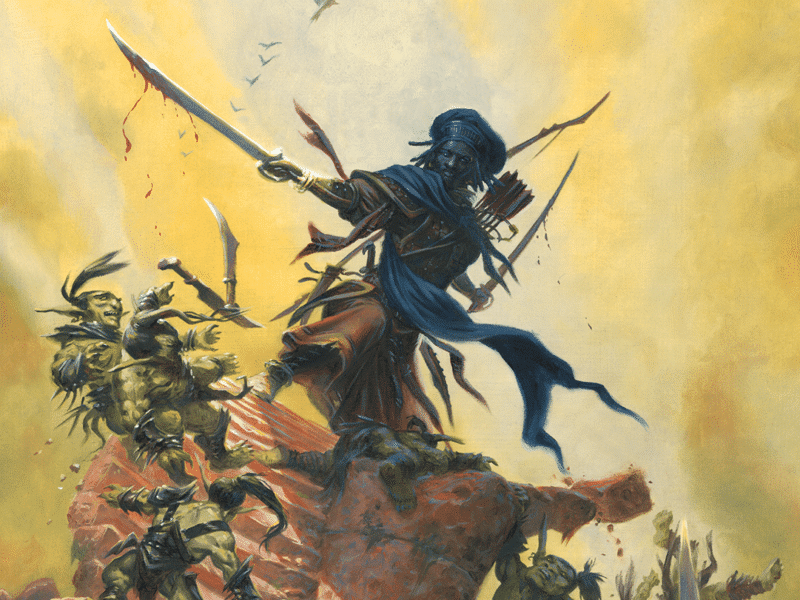This is yet another in the series in which we’re looking at ways to run adventures in D&D in specific types of environments! We’ve covered lots of natural places so far, such as freezing cold arctic regions and scorching hot sandy dunes – but this time, we’re off to an entirely different and far more artificial location that’s to be found in a regular fantasy setting: the town. Come along and let’s pass through the city gates as we discover what might make questing among houses and streets interesting!

Traditionally, adventuring in Dungeons & Dragons means equipping oneself for travel in the rugged wilderness, camping in deep forests, trekking across mighty mountains and murky swamps, delving into haunted tombs and dungeons riddled with horrible traps, defeating a range of familiar or strange monsters, claim the treasure that the aforementioned monsters are guarding (or just happened to live nearby), and – hopefully – return safe back to the tavern to brag about one’s phenomenal and heroic deeds. Then you invest your hard-earned coin and gems in new gear, comfortable lodgings, excessive servings of mead and roast, and possibly a magic item or two. You might even splash out on a brand-new residence or find that you have to spend some of your wealth on resurrecting a fallen comrade. Then a new quest giver appears (probably in your favourite tavern) to offer you an opportunity to embark on a new adventure, and the cycle begins anew.
And that’s great! I’ve played hundreds upon hundreds of adventures that have been slight variations on the above, with the majority of them taking place in either a forest, a dungeon, or both. Throw castles, marshes, and mountains into the mix, and these environments will cover probably ninety-five per cent of every adventure that I’ve taken my characters on. However, I’ve found that there is an environment which affects many of the heroes’ conditions, and also tends to alter the fundamental aspects of the adventure that they’re undertaking – and that’s a town.
A better word might be “settlement”, as many of the consequences, possibilities and options outlined in this article apply not only to towns but virtually all settlements, including tiny hamlets, small villages, busy cities, and sprawling metropolises.
The main reasons that these environments open so many new routes for how a D&D adventure might be written and how it can play out are found in the presence of two things: people and infrastructure. By people, I mean both important NPCs that are directly involved in the adventure as well as hapless inhabitants that just mill around the place and work as a backdrop to more central events. When I use the word infrastructure – not the most fantasy-sounding of terms, I grant you! – I’m referring to houses of all sizes, streets and canals, and all other structures and passages that are found in a settlement.
Here are a few ideas for how to use these to your advantage as a DM and to create adventures with a distinct flair that can be wildly different to a typical D&D adventure.
Hidden agendas and secret schemes galore
Let’s begin with the one thing that makes a town what it is: all its inhabitants. And where there are people, you’ll also inevitably find envy, desire, vengefulness, and deceit. Even the calmest village will have its share of plotting and rumour-spreading, and cities can be absolutely brimming with complex schemes. Hence, the options are endless when running adventures based on these themes – especially if the adventuring party doesn’t mind taking on morally questionable tasks.
Let’s say there’s a wealthy merchant who recently arrived in town and has built a hugely successful business in only a few months. The commander of the guards is viewing this as a bit suspicious and doesn’t like the arrogant merchant’s attitude, so they hire the adventurers to investigate a particular warehouse in which the commander suspects that the merchant is hiding something that’s illegal to sell (or maybe it’s an enslaved monster that the merchant uses to threaten their competitors – this is Dungeons & Dragons, after all!). Alternatively, if the characters are a little unscrupulous, they might be offered a reward by a merchant who doesn’t like a rival who is doing well for themselves, so the merchant wants the characters to plant something illicit or dangerous in the rival’s shop.
Spy missions are also great for town-based settings. Perhaps a local ruler, high priest, archmage, or rich aristocrat has been wronged (or at least thinks they’ve been so) by another inhabitant, and approaches the characters to ask them to snoop into someone’s business or household and return to the quest giver with gold, gear, or information. What’s great about missions of this kind when they’re set in towns is that the characters might have to use unusual tactics and skills. When exploring a shadowy cult’s activities in a temple situated in the middle of nowhere, subtlety might be preferred but not critical, so kicking down doors or starting a huge brawl might not be the end of the world. However, in a town, this kind of behaviour might simply not be an option, which means the characters must take great care to be sneaky and retreat to regroup if something goes wrong. Suddenly, silence and finesse become the key elements, and the characters might have to stake out a place in advance to avoid surprises. (An important side note: this kind of quest should never hinge on a dice roll – in other words, a single failed Stealth check shouldn’t result in that the whole mission ends in disaster. Instead, it’s better to “fail forward,” so that a few failed checks generate a little complication rather than a big disaster. Likewise, if a catastrophic event or a huge number of failed checks eventually sees the characters caught, there should ideally be a way for them to escape their captors.)
But the characters could also be required to obtain information through different means such as infiltration! In such circumstances, they might have to rely on their acting skills rather than their prowess with arms, and pose as servants, couriers, nobility, traders, or some other role. Trust me, having a barbarian or a paladin doing their best to behave like a servant, or asking a wizard to act as a fighter, are great recipes for laughter.
In addition, towns make for perfect places to snare the characters in nasty webs of intrigues. For example, different NPCs might contact the adventurers with offers to carry out certain quests in the town, which might at first look like a simple way to make lots of coin with little effort. But then it is revealed that the NPCs are enemies with one another, and have tried to hire the characters for missions that will cause problems for their respective adversaries.
Keep your voice down!
On a related note, one thing that’s worth keeping in mind at all times as the DM is that in a town or even a village, there are eyes all over the place. A small settlement might have a single watch around the clock who patrols the location and makes sure that the farmers’ cattle are safe, or a few youngsters who sneak around at night just for fun. There might even be a guard dog or another creature with a similar role that starts to bark (or meow, or caw…) with it spots an intruder.
In bigger places such as proper towns, there are usually lots of guards who monitor the area from towers and walls, and also by patrolling the streets and outskirts in groups of three or more. Such guards might have armour, good weapons, the skill to use said weapons, and bells or horns for sounding alarms when they discover that something is out of place. What’s more, a large town never sleeps: there’ll be revellers stumbling in and out of taverns, travellers arriving late or leaving early, shops with extensive opening hours, and other characters who are out and about.
This means that it can be seriously problematic to get away with any mischief in a town. Anyone who plans to break into a building will benefit from getting a good idea of the layout of the location and how people move around it before they attempt anything foolhardy.
Locks and traps
The above point is closely related to this one: in a dungeon that’s been lost for aeons, there might be plenty of big, clunky traps that run or massive gears as well as lots of locked doors, although it’s often the case that such doors are easy to bash in. However, there are usually also many openings such as archways or natural passages that are just that: open. Compare that with towns, where – especially in large cities – there are doors everywhere. What’s more, if it’s a huge settlement, it’s increasingly likely that the doors that really matter will be locked or barred by other means, and not by age-old crumbling latches but new and snazzy locks made by skilful gnomes or dwarves. Similarly, if an important door in a town is trapped, it’s likely for good reason – which in turn means that it probably has been rigged with a device that’s hard to detect, difficult to detect, and terribly deadly! Some doors might even be fitted with magic or mechanical alarms that create a terrible din which alerts every guard in the neighbourhood, which isn’t ideal if one is trying to steal an item and disappear into the night.
Consequently, if a group of adventurers want to move around a town discreetly and check out various locations without anyone else knowing about it, as they might be able to do in a remote underground dungeon far from prying eyes, the adventurers are in for a challenge as merely getting access to a single room can be a real hurdle!
It’s a topsy-turvy landscape!
When it comes to chases, races and crazy battles, towns offer a kind of battle map that no other environment does: rooftops! A hunt, escape or manic fight on top of a sea of tiles and chimneys is a brilliantly scenic event, and it also opens to a lot of fun ideas for special rules.
For example, let’s say that the adventuring party is pursuing a group of bandits who have robbed the local goldsmith. The bandits flee up on the roof of an inn and leap over to the rooftop of an adjacent building. The characters scramble up and set off after the miscreants. Time to come up with some new checks! The characters (and the bandits!) might have to pass a check to leap over the gap between two buildings. It’s neat to keep the race going, so in this instance, a failed check might result only in that the person slips and loses some speed. Next, there might be unusually steep roofs that require successful Athletics checks to climb and slippery tiles that require successful Dexterity saving throws to cross safely. There might be hazards, such as pipes belching hot smoke, aggressive territorial birds that start to peck at the characters – or other NPCs such as guards or rivals who join the fray and add to the chaos.
Combat is equally entertaining! If someone makes ranged attacks but misses, the stray missile (or spell) might strike a chimney, tower – or the sack of gold that the bandits are cradling. In melee, the combatants might have to make saves to avoid being knocked off the roof, and those who have the higher ground (in other words, standing farther up a tilting roof) might have a bonus on their rolls.
Get out of the way!
A quick note on the perils of town-based adventures: they’re not well suited for rampaging characters who care nothing for the wellbeing of others – and this is especially true for certain spellcasters (I’m looking at you, evokers). If things go wrong and a sorcerer starts flinging their most powerful spells, the consequences can be spectacular and unfortunate. For example, throwing a burning torch or lantern at a patch of oil as part of an attack or to scare monsters away is usually safe to do in a dungeon. Even when in a forest, it’s often not a major problem as a typical forest isn’t exactly flammable unless it’s very dry. However, an errant fireball cast in the middle of a town square can ignite a whole house in an instant, a lightning bolt that misses its target can electrocute bystanders, and a thunderwave can topple an entire inn with the wave of a hand.
Boss fights
I’ve saved one of the things that I enjoy the most about towns for last. As we all know, the archetypal D&D adventure ends with a climactic showdown as the characters take one or more particularly dangerous monsters – the dragon in its vast lair, the troll at the end of the dungeon, the minotaur in the middle of the labyrinth or the giant in its throne room. And I love it! There’s something so cinematic and comfortably classic about these endings that makes me feel like I’m part of a legend or in a movie.
When adventuring in a town, there’s nothing stopping a DM from ending a quest in the same fashion – after all, there are lots of adventures in which the heroes must battle huge monsters that have invaded or secretly built a lair inside the walls of a city. But final fights that take place in towns enable certain possibilities that can be used to make them more thrilling, complex, and – for the characters – complicated.
For example, let’s pretend that the adventuring party has tracked down a nefarious mastermind who is the head of a demon-worshipping cult that meets regularly in the basement of the town’s biggest inn. The leader – the adventure’s main villain – is an elusive figure who shows up only at the cult’s meetings, so the characters must attack him when one of these is underway – but the cultists arrive through secret doors that lead to the sewers, so there’s a risk that many of them (including the leader) might slip away. And it gets worse! Unfortunately, the meetings happen only on weekends when the inn is brimming with revellers, and the inn itself is situated in the middle of town with dozens of buildings right next to it. The problems don’t end there: the leader is also known to be utterly ruthless and a powerful warlock who can summon hideous demons and hurl fiery spells with ease.
In this scenario, the characters must figure out how to launch their attack without causing a catastrophe that results in innocent people being caught in the crossfire and enormous damage being dealt to the adjacent houses.
Those were a handful of thoughts on how town-based adventures in Dungeons & Dragons have their own unique flair. So if you’d like some variation from quests that send the heroes into lush forests or gloomy dungeons, look no further than the next large settlement in your setting!






